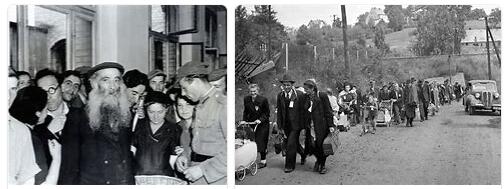The post-war territorial changes contributed to radically transform the economic structures and functions of Poland, a predominantly agricultural country until the Second World War. After the first phase of reconstruction from the devastation of the war, the new socialist government issued important measures regarding the nationalization of industry and commerce and agrarian reform. From the very beginning, economic and territorial planning assumed the characteristics of a strong centralization, in conformity with the Soviet economic system and with that of the other People’s Republics of Central and Eastern Europe. The post-war agrarian reform mainly involved the annexed territories in the western and northern parts, where the ‘socialized’ sector of agriculture thus came to predominate. represented by large and medium-sized state and cooperative companies. In the other regions, on the contrary, the private sector continued to dominate, consisting mainly of small farms (2-5 ha on average) and in several cases even units of less than two hectares. At the end of the 1980s, the radical political-economic changes that involved the Soviet Union and consequently the countries of socialist Europe also affected Poland, triggering from the economic point of view a complex and difficult phase of transition from the productive and distributive of a state or socialized type to that of the free market and promoting the influx of conspicuous investments from the most technologically advanced countries of the West. Particularly, the reconversion of the large sectors of heavy industry structurally in crisis and the privatization of various sectors of socialized production were favored, with the aim of increasing the economic recovery, and therefore of attenuating the substantial migratory flow of the youth classes towards Western Europe and North America. Since the 1990s, Poland has carried out a broad and complex plan for the conversion and development of the national economy, in order to promote the country’s inclusion on the international scene and its entry into the European Union (which took place in 2004). Trade was liberalized and the state launched measures aimed at gradually opening the market to foreign capital.
Agriculture still plays an important role in the economy: just under half of the territory is used for arable land and about 17.4% of the active population is employed in the primary sector (2009). Poland is a good producer of wheat, barley and oats and is the first world producer of rye, after Russia. Also important is the production of potatoes, a staple food for Poles. Among the industrial crops, sugar beet stands out in particular, which ensures one of the largest production of raw sugar in Europe. Less important are horticultural products and tree crops (however, the production of apples is noteworthy). Breeding is very widespread, especially of pigs (18,800 million head), but also of cattle and poultry, and sea fishing is practiced with profit.
Post-war territorial changes have contributed to altering both Poland’s energy potential and mineral resources. To the west, it has encompassed the mining and industrial districts of German Silesia; to the east, on the contrary, it had to cede most of the oil and natural gas fields of the northern Carpathian region, and the potash mines to the Soviet Union. The Upper Silesian district is one of the richest European coalfields (143.5 million tonnes of coal extracted in 2008) and supplies almost all of the national production, largely destined for export despite the substantial internal consumption for industrial and domestic. Brown coal is also abundant (59.4 million tonnes), while oil and natural gas production is scarce. Excellent positions of Poland in the European rankings of producers of metallic minerals (lead, copper, zinc) and also of precious metals such as silver, of which the country is one of the largest suppliers in the world. The production of electricity continues to rely largely on the combustion of coal, while a setback has occurred in the use of nuclear power. For Poland economics and business, please check businesscarriers.com.
Thanks to its mineral wealth, Poland is endowed, especially in its southern part, with an important steel, metallurgical and mechanical industry; of the latter the sector of construction of means of transport is particularly developed (plants for the production of railway material and motor vehicles, as well as shipyards, the latter in the North: Gdansk, Gdynia and Szczecin). Another traditional Polish industry which is rapidly modernizing is the textile industry, concentrated in the Łódź area for cotton and in southern Poland for wool. There is also a robust chemical industry, linked to the production of coal, the importation of oil and also to various salt deposits. Food industries are also developed. Not negligible is the growth of other sectors, such as electromechanical, woodworking, paper and glass.
This complex of economic activities feeds a well-articulated foreign trade, which mainly sees industrial products exported, but also raw materials such as coal and metal ores. The main trading partners of Poland are the EU countries (in particular, Germany, France and Italy) and Russia. Tourism is mainly directed towards the historical and cultural centers, the southern mountains, the lake regions and the seaside resorts on the Baltic.
The post-war territorial annexations contributed to the expansion of Poland’s maritime outlet to the N: the ports of Gdansk and Szczecin were added to the artificial port of Gdynia, built in the interwar period to provide the country with an opening onto the Baltic. The shift of the western border along the Oder-Neisse river route greatly contributed to the improvement of inland navigation: the network of waterways, between navigable rivers and artificial canals, reaches 3660 km (2008) and facilitates heavy transport, which they have in Koźle, on the Oder, the largest mining port. As regards traffic, a road network improvement plan (383,053 km in 2007) is being implemented – with the construction of freeways and motorways, of which the country is lacking – and the railway network (20,196 km of which 11. 924 km electrified in 2008). The main airports are those of the capital, Łódź, Krakow and Wroclaw.
